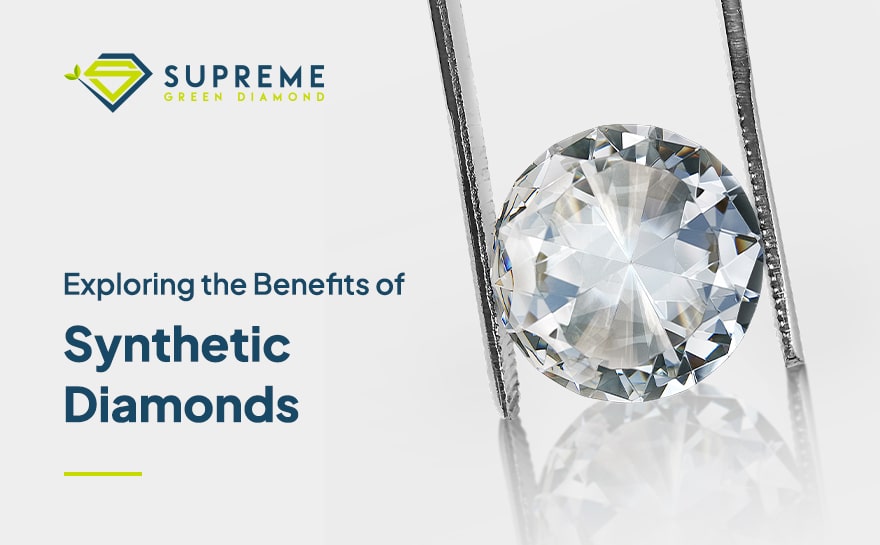In recent years, synthetic diamonds have grown rapidly in popularity. They provide a high-quality, affordable alternative to natural diamonds, offering both beauty and practicality. With increasing awareness around sustainability and ethics, lab-grown diamonds are becoming the preferred choice for consumers worldwide.
What Are Synthetic Diamonds?
Synthetic diamonds, also called lab-grown or laboratory-created diamonds, are produced in controlled environments using advanced technology. Unlike natural diamonds, which take billions of years to form deep within the Earth, synthetic diamonds can be created in a matter of weeks while replicating the same physical, chemical, and optical properties.
How Are They Made?
There are two main methods used to produce lab-grown diamonds:
– High Pressure High Temperature (HPHT): Replicates the natural diamond formation process using extreme pressure and heat.
– Chemical Vapor Deposition (CVD): Builds diamonds layer by layer from carbon atoms, allowing for precise control and customization.
Both methods yield diamonds identical to natural ones in appearance and durability.
Why Choose Lab-Grown Diamonds?
Eco-Friendly and Ethical
Mining natural diamonds has long been associated with environmental harm and ethical issues. Lab-grown diamonds are created with far less environmental impact and avoid concerns like conflict diamonds, making them a sustainable and responsible choice.
Cost-Effective Luxury
Lab-grown diamonds are typically 30–40% more affordable than their mined counterparts. This cost advantage means buyers can often purchase larger or higher-quality stones for the same price as smaller natural diamonds.
Superior Quality and Purity
Thanks to controlled production, lab-grown diamonds frequently contain fewer impurities than natural diamonds. Many are nearly flawless, ensuring exceptional brilliance and consistency.
Variety and Availability
Synthetic diamonds can be produced in a wide range of sizes, shapes, and colors, offering far more choice than natural sources. Whether you want a traditional round stone or a fancy-colored diamond, lab-grown options are readily available.
Larger Diamonds, Lower Cost
For those who dream of statement jewelry, synthetic diamonds make larger carat sizes attainable without sacrificing beauty or budget.
Applications Beyond Jewelry
Jewelry Industry
From engagement rings to earrings, lab-grown diamonds are redefining modern jewelry. Their ethical origins and lower price points resonate strongly with today’s socially conscious consumers.
Industrial Uses
Diamond’s unique hardness and thermal conductivity make it valuable beyond adornment. Lab-grown diamonds are widely used in cutting, grinding, drilling, electronics, and high-performance manufacturing tools.
The Future of Synthetic Diamonds
As technology continues to advance, lab-grown diamonds will become even faster and cheaper to produce. Demand is expected to rise across both the jewelry and industrial markets. In particular, CVD technology is driving innovation, enabling diamonds to be engineered with tailored properties for specialized applications.
Conclusion
Synthetic diamonds combine beauty, affordability, and sustainability. They are reshaping the jewelry industry while also powering innovation in technology and manufacturing. Whether you’re searching for a sparkling engagement ring or durable industrial material, lab-grown diamonds are a smart and ethical choice. The future shines bright with endless possibilities.
FAQs
1. What are synthetic diamonds?
They are lab-created diamonds with the same physical, chemical, and optical properties as natural diamonds but produced in weeks inside controlled labs.
2. How are synthetic diamonds made?
Through HPHT (high pressure, high temperature) or CVD Diamonds (chemical vapor deposition), which both create genuine diamonds.
3. Why are they eco-friendly and ethical?
They avoid the environmental damage and human rights issues linked to traditional diamond mining.
4. What are the main benefits?
Lab-grown diamonds are affordable, often larger and purer than natural diamonds, available in many varieties, and useful for both jewelry and industrial applications.
5. What’s the future of lab-grown diamonds?
As production becomes more efficient, synthetic diamonds will be cheaper, more customizable, and in higher demand across industries.

